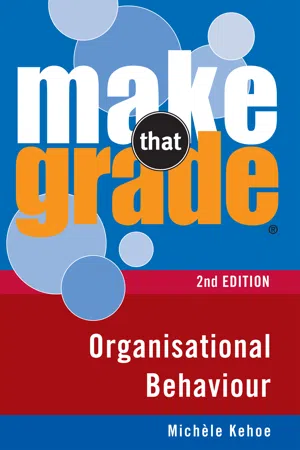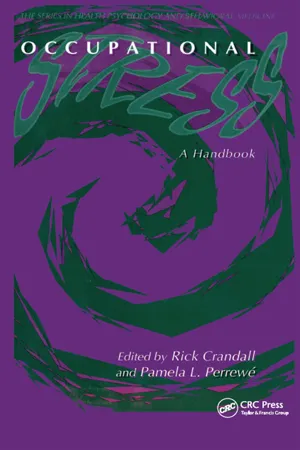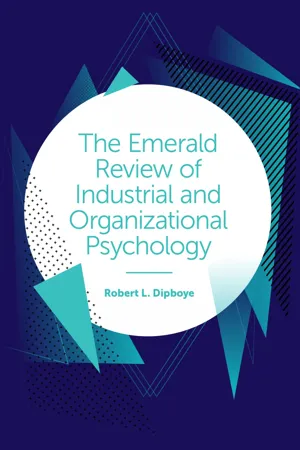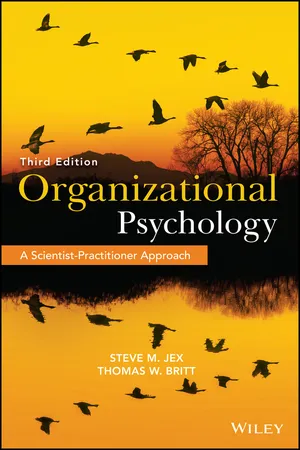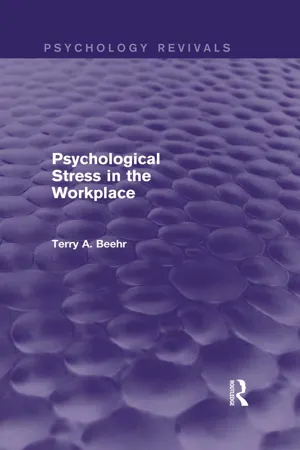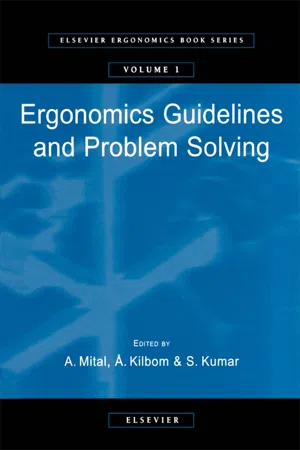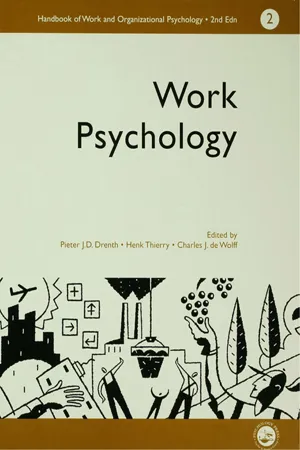Psychology
Workplace Stress
Workplace stress refers to the emotional, physical, and mental strain experienced by individuals in their work environment. It can result from factors such as heavy workloads, tight deadlines, and interpersonal conflicts. Chronic workplace stress can lead to burnout, decreased productivity, and negative impacts on overall well-being. Employers often implement strategies to mitigate workplace stress and promote a healthier work environment.
Written by Perlego with AI-assistance
Related key terms
Related key terms
1 of 4
Related key terms
1 of 3
10 Key excerpts on "Workplace Stress"
- eBook - ePub
- Michele Kehoe(Author)
- 2013(Publication Date)
- Gill Books(Publisher)
6 STRESS IN THE WORKPLACE Objectives This chapter will help you to: Define stress. Describe the General Adaptation Syndrome. Identify the difference between eustress and distress. Characterise Type A and B personality profiles. Examine the causes of life and organisational stressors. Understand the consequences of stress to the individual and the organisation. Recommend individual and organisational coping strategies. 6.1 Stress defined Stress is complex and the experience of it is very individual due to its many causes and consequences. Stress is a reality of life in general and therefore part of the experience of work. The most important aspect of stress is managing it effectively. The benefits for organisations in creating a work environment that helps employees manage the demands of life within and without the workplace include healthier employees, reduced absenteeism, increased productivity and an enhanced reputation. According to Moorhead and Griffin (2012), stress can be defined as ‘ a person’s adaptive response to a stimulus that places excessive psychological or physical demands on that person ’. The source of stress must be perceived by the person to be excessive. Wagner and Hollenbeck (2010) assert that stress is ‘ an unpleasant emotional state ’. Arroba and James (1991) state that stress is ‘ a person’s response to an inappropriate level of pressure. It is a response to pressure, not the pressure itself. ’ This description of stress highlights the fact that stress is caused by pressure from many different sources, such as peer pressure, financial pressure or exam pressure. It is when an individual believes that the pressure they are under is too much for them to handle that stress is experienced. When placed under a lot of pressure, some people experience no stress and others only need a small amount of pressure to suffer the side effects of stress - eBook - ePub
Occupational Stress
A Handbook
- Rick Crandall(Author)
- 2020(Publication Date)
- CRC Press(Publisher)
A transactional, process, and appraisal- (or meaning) centered approach to stress offers a very different perspective on work stress, and stress in general, than what has been traditional. It has a number of profound implications for (a) the way research is conducted and (b) efforts to ameliorate stress by interventions aimed at prevention and treatment. I shall address some of the most important of these implications below.The Conduct of Research
It should come as no surprise that many conditions of work such as time pressure, noise, work overload, lack of decisional control, role ambiguity, conflicts with superiors and subordinates, and so on, are stressful for large numbers of workers. Likewise, certain types of persons, for example, rigid personalities, those addicted to drugs, those with neuroticism, with a tendency to depression, etc., are likely to react with stress more often or more intensely than others. Recurrent and intense stress will, of course, increase the incidence and severity of symptoms such as emotional distress, disruptions of performance, illness, absenteeism, and so on.Although this kind of knowledge has value, it misses the central point that the sources of stress are always, to some extent, individual, as are the ways people cope with stress. One worker is upset primarily about his relationships with others in the shop. For that worker, being accepted and liked is of the greatest importance. Another worker is upset primarily about evaluations by his supervisors, or about whether he will advance in position and salary. For him, success in the job is of the greatest importance. To describe and understand stress in the workplace requires that these individual patterns be studied to generate knowledge about the kinds of persons who are more or less vulnerable to divergent sources of stress.In their excellent discussion of stress, coping, and the meaning of work, organizational psychologists Locke and Taylor (1990) have written the following about individual meanings of work:… the meaning of work varies widely among individuals in our society. While each of us can observe this variation from personal experience, the research literature provides even stronger evidence of such differences. In one of the earliest studies of the meaning of work, Morse and Weiss (1955) examined a sample of 401 American males, and found that individuals in middle class and farming occupations tended to emphasize the intrinsic interest and significance of their work, whereas those in lower class occupations viewed work simply as an activity that kept them busy. Similarly, Near, Rice, and Hunt (1980) reviewed the literature on work and nonwork domains and concluded that the importance of work varied by occupation; people in higher skill jobs saw their work as more important than those in lower skill jobs. Finally, Buchholz (1978) examined the work beliefs of over one thousand individuals including employees, union leaders, and managers and found individual differences according to age, education, and occupation. Young people displayed a stronger pro-work ethic than did older people, and those with graduate education expected more intrinsic outcomes (e.g., interest, challenge) from their work than those with less education. - Robert L. Dipboye(Author)
- 2018(Publication Date)
- Emerald Publishing Limited(Publisher)
As illustrated in these accounts, work stress is increasingly recognized as a serious problem in countries around the world. Perhaps the most serious threat is to mental and physical health. Stress is implicated either directly or indirectly in such life-threatening illnesses as cancer, heart disease, diabetes, cirrhosis of the liver, stomach and intestinal ulcers, arthritis, and lung disease. The most widely consumed prescription drugs treat anxiety, depression, and other symptoms of stress. The widespread acknowledgment of this “stress epidemic” has prompted many people to try jogging, meditation, diets, counseling, support groups, and even new lifestyles. This concern has spread to industry, where business leaders have openly expressed alarm about the spiraling costs their organizations incur from stress-related absenteeism, decreased productivity, and medical expenses. Although it is difficult to estimate the true cost of work stress (see Goldin, 2004), various estimates in the United States range from as high as $300 billion to $50 billion per year. Stress negatively affects the bottom line, but employers also have an ethical and, in some cases, a legal obligation to protect worker health. To deal with the problem, corporations have provided stress management workshops, wellness or health maintenance programs, and exercise facilities. Decreasing employee stress, however, requires an understanding of exactly what it is.Much of the information on stress emanates from its historical roots in medicine and clinical psychology and targets the individual. The spiraling costs to organizations of stress-related outcomes such as illness, injury, absenteeism, and low productivity have compelled researchers to broaden their perspective and take into consideration work and the organization. This chapter is organized into three major sections. The first introduces the concept of stress. The second deals specifically with the sources and outcomes of job-related stress and the characteristics of people that make some more vulnerable than others. The last section is concerned with the management of stress, both at the individual level and organizational level of intervention.Definition of Stress
So, what is stress? Before providing a working definition, I need to correct several popular misconceptions (Selye, 1974). Stress is not something that can or should be eliminated entirely. Many of the most stressful events in your life are the challenges and excitement making life worthwhile. Stress is not simply something occurring in your head to be ignored. Stress has real consequences for mental and physical well-being. Stress is not simply a matter of anxiety or nervous tension you can eliminate by calming your emotions. Stress also consists of physiological reactions that are often unconscious and not controllable. Finally, stress occurs not only as a result of overstimulation and overexcitement but also from boredom and understimulation. Jobs experienced as monotonous and requiring long periods of inaction are often just as stressful as dangerous or exhilarating jobs.- eBook - ePub
Organizational Psychology
A Scientist-Practitioner Approach
- Steve M. Jex, Thomas W. Britt(Authors)
- 2014(Publication Date)
- Wiley(Publisher)
Another indication of the harmful effects of occupational stress is the increasing trend toward stress-related workers' compensation claims (DeFrank & Ivancevich, 1998; National Council on Compensation Insurance, 1988 1991). In the past, compensation for work-related injuries was limited to physical injuries caused by some physical event or stimulus. Increasingly, however, more and more states are recognizing the legitimacy of physical and even psychological injuries that may be caused by some stressful aspect of the work environment that is not physical in nature (e.g., an overly demanding supervisor). In fact, a trend in recent research is to examine the intersection between psychological and physical risk factors in the prediction of both psychological outcomes (e.g., depression, burnout) and such physical outcomes as accidents (Kaplan & Tetrick, 2011).Occupational stress and employee health are also important because of their impact on society as a whole. It is unlikely that people experiencing constant stress on the job will function effectively in their other roles, such as husband/wife, parent, neighbor, and community member. Failure to perform these roles effectively may not have direct economic costs but may, in the long run, have a tremendously negative impact on society. Thus, occupational stress is clearly not the “cause of all societal ills,” but it does have an important and real impact on individuals, organizations, and society. Given the emphasis in this chapter on occupational stressors as predictors of health and well-being, it is worth highlighting that we view health and well-being in terms consistent with Jex, Swanson, and Grubb (2013). These authors highlighted that health and well-being should be considered as not only representing the absence of physical symptoms, but also the presence of positive psychological states and behavior.A Brief History
The earliest scientific investigations related to the field of occupational stress were conducted by the well-known physiologist Walter Cannon in the early part of the 20th century (e.g., Cannon, 1914). Cannon's work focused on the relationship between emotions and physiological responses, and is considered the earliest work in the field of psychosomatic medicine (the relationship between psychological states and physical illness). Cannon, however, is best known for having coined the term homeostasis - Terry Beehr(Author)
- 2014(Publication Date)
- Routledge(Publisher)
Part III Outcomes of stress in the workplaceOne of the necessary parts of the definition of occupational stress offered here consists of aversive outcomes to the individual — the strains. Organizational stressors lead to individuals’ strains and the first chapter of this section examines three types of strains: psychological strains, physical or physiological strains, and behavioral strains. These have not been studied and documented in equal proportion to each other in research from the organizational psychology point of view of job stress. The psychological strains have dominated research from this approach, probably because of a combination of researchers’ interests, researchers’ expertise, and the variables’ ease of measurement. The common thread in the fabric of these three strains is that they are deleterious to the individual experiencing them.The second chapter in this section of the book focuses on outcomes to the organization. These are not strains in the language used here and they are not by definition a necessary part of job stress. If they occur, however, they are important, albeit more so to the organization than to the individual. Outcomes of individuals’ stress to the organization could be either positive or negative, but past discussions in the literature have often either assumed or noted only the negative ones. Compared with the individual outcomes or strains, even less is known very clearly about the organizational outcomes of individuals’ occupational stress.Passage contains an image
Chapter 5 Individuals' strains Psychological, physiological, and behavioral effects of Workplace Stress
DOI: 10.4324/9781315795560-8The direct measurement of activation level will be difficult since students and employees alike will not be eager to have electrodes implanted in their brainstems.(Scott, 1966 : 25)By definition, occupational stressors lead to strains, at least for most people and under most conditions (Kahn and Byosiere, 1992- eBook - ePub
- Maureen Dollard, Helen R. Winefield, Anthony H. Winefield, Maureen Dollard, Helen R. Winefield, Anthony H. Winefield(Authors)
- 2003(Publication Date)
- CRC Press(Publisher)
This study has indicated that there is no geographically related difference in terms of what it means to be a psychologist in Australia. Rural psychologists do not constitute a different professional group. They share the same priorities and values and concerns as their urban colleagues. That is, it means the same thing to be a psychologist whether one is in the urban or rural sector. However, in the course of their work R/R psychologists are exposed to contextual differences that appear to result in more stress related appraisals, differential relevance of stressors and qualitative differences related the nature of the encountered stressors. These distinctions are important for the provision of appropriate stress-management interventions, support and training experiences designed to equip psychologists for working in different contexts.13.7 CHAPTER SUMMARY
This chapter has attempted to map the research efforts in psychological work stress using a model of occupational stress derived from the broader work stress literature. The piecemeal nature of these research efforts in addition to what is largely a substantive interest in psychological work stress results in a body of knowledge that is difficult to utilise in the service of professional support and enhancement.Despite these limitations a growing body of work is emerging that both sheds some light onto the nature of stress in psychological work and provides a basis for future research. Using the Matteson and Ivancevich (1987); Ivancevich and Matteson, (1980) model to integrate the research there is a reasonably clear picture emerging of both the broader sources of stress and the types of stressors that affect psychologists in their professional work. The identification of stressors and the development of measures such as that published by Cushway and Tyler (1994; 1996) permit coherent and organised research efforts, whereas the acknowledgement of the role of contextual factors on work permit research efforts that can be tailored to specific subsets of practitioners.Unfortunately, the dominant position of burnout as a strain construct tends to obscure other fruitful areas of exploration in the area of strain. Stress per sé does not have negative implications. The duration, level and/or extremity of stress required to compromise practitioners can only be determined by understanding more about the nature and diversity of compromised states. This is an important area for research. For example, in rural and remote Australia, attrition from the profession, the job and/or the geographic location of work may be one of the most damaging forms of strain outcome for an already compromised health service. - eBook - ePub
- A. Mital, Å. Kilbom, S. Kumar(Authors)
- 2000(Publication Date)
- Elsevier Science(Publisher)
Managing stress in the workplace: Part II – The scientific basis (knowledge base) for the guide
Ann M. Williamson, National Institute for Occupational Health and Safety (Worksafe Australia), P.O. Box 58, Sydney, Australia 20011. Problem description
The stress response is the body’s natural reaction to situations that are perceived to require more than the normal or comfortable amount of effort to achieve required performance. Situations that are unfamiliar to the individual or that challenge or threaten them in some way will produce a stress response. One of the pioneers of the area of stress, Hans Selye, described stress in terms of the nonspecific result of any demand made on the body (Selye, 1936 , 1982 ). This could include situations that are well-recognised to produce a stress response in individuals not used to them, like having to speak in public, taking on a new or difficult task, or undergoing examination or inspection. In all of these situations the physiological, psychological and behavioural changes that form the stress response have beneficial effects on performance. Biochemical and other changes help to, amongst other things, increase the level of energy and muscle tension of the individual and improve their ability to concentrate on the task at hand, thereby helping to enhance their performance. A certain level of stress that brings about these sorts of changes is a necessary aspect of maintaining productivity.A very large amount has been written about when stress occurs, and many theories and models have been developed (Eichler et al., 1986 ; Kahn and Byosiere, 1992 ). This is an important issue because the model which describes when stress occurs will provide the framework for all other work on the problem, including how it is prevented and managed. The earlier models of stress emphasised the biological processes involved and described stress as occurring when the body state changed in response to external demands (Cannon, 1935 ; Selye, 1936 , 1982 ). Later models emphasised the interaction between the environment or situation (stressors) and the person, for example the Person–Environment Fit model (French et al., 1982 ) or the job demands and control model (Karasek, 1979 ). More recent models have been based on the same person-environment relationship but have focussed on different features. For example some models have emphasised the transactional or process-oriented nature of the relationship between the person and their environment (Lazarus and Folkman, 1984 ; Cox, 1978 ), and others have included the role of moderating or mediating factors like age, education and the amount of social support in the person-environment relationship in addition to the other acknowledged factors (Ivancevich and Matteson, 1980 ; Kahn and Byosiere, 1992 - eBook - ePub
The Psychology of Behaviour at Work
The Individual in the Organization
- Adrian Furnham(Author)
- 2012(Publication Date)
- Psychology Press(Publisher)
7 Stress at workIntroductionAll jobs are potentially stressful, although the stresses vary widely. Some jobs are incredibly boring, involving machine monitoring or property guarding, and others are over-stimulating and physically demanding, leading to exhaustion. Stress is certainly pervasive. In a recent study of the 147 million workers in the European Union, 30% complained of backache, 28% of stress, 20% of fatigue, 17% of muscular pains and 13% of headaches (Paoli, 1997). There is certainly nothing new about either the acuity or chronicity of work stress, except perhaps the rapid rise in the number of people claiming to be stressed. Due to the popularity of the idea, and thanks to saturated media coverage, most people have learned to recognize classic symptoms: changes in eating, drinking, smoking patterns; irritability and moodiness; absent-mindedness, tiredness and exhaustion; anxiety and depression; negativism and susceptibility to illness.The word “stress” is derived from the Latin word stringere, which means “to draw tight” (Cox, 1978). It is such an overused and elusive term that many have agreed it should be completely abandoned. Many definitions exist: some believe stress can and should be subjectively defined; others feel one needs an objective definition. Some researchers believe a global definition is appropriate; others emphasize that stress is multidimensional. Until the eighteenth century, it colloquially implied hardship, adversity or affliction. It was later used by physicists to describe a force exerted upon an object, so that resultant changes in volume, shape and size were called “strains”. Hence, “stresses and strains”.Sometimes a concept becomes so oversized and extended it becomes meaningless. That happened to “alienation” for sociology and “neurosis” for psychiatry. Is the same true for stress? It has been seen as a confounding, dependent, epiphenomenal, independent, intervening and moderating variable. Briner (1999) has put forward a good case for abandoning the concept in favour of “feeling/emotions at work”. He notes quite correctly that stress is both stimulus and response. It is, at one and the same time, thought of as cause and consequence, trait and coping style, biological phenomenon and disrupter of performance. Because of this terminal confusion, the research is often bad. Even more provocatively, Briner (1999) believes that stress is a modern myth because the better the research, the more the evidence for the relationship between work stress and personal reactions evaporates. - eBook - ePub
- Jay C. Thomas, Michel Hersen(Authors)
- 2002(Publication Date)
- SAGE Publications, Inc(Publisher)
Before embarking on our review, however, we present a simple stress framework to guide the discussion. Specifically, we propose that some external source of stress, or stressor (e.g., a demanding supervisor at work), provokes a stressful cognitive appraisal (Lazarus, 1966), which leads to a stress response (Cannon, 1932). This stress response has physiological (e.g., increased heart rate, respiration); psychological (e.g., fear); and behavioral (e.g., fleeing the scene) components. If the stressor continues and/or is joined by other stressors, stress outcomes, such as headaches, high blood pressure, depression, and decreased work performance, may occur. If unabated over time, the stress process can produce more serious, chronic decrements, such as heart disease, clinical depression, and alcoholism, which are collectively called strains. Variables that can effect this process are usually called stress moderators; for example, both men and women report being stressed, but women often report more psychological stress responses (e.g., depression), whereas men report more physical stress responses (e.g., backache) (Jick & Mitz, 1985). We define stress as a function of the stressor(s), cognitive appraisal, stress responses, stress outcomes, strains, and stress moderators. Any reference to stress in this chapter refers to this total process (Ganster & Schaubroeck, 1991; Smith & Sulsky, in press).REVIEW OF THE RESEARCH: MAJOR TOPICS ON WORK STRESS AND HEALTH
We have selected five contemporary research topics on work stress and health—stressful life events and daily hassles, Type A behavior pattern, burnout, social support, and perceived control—to discuss in this chapter. Although these topics are certainly not all-inclusive, we consider them to have had a major impact on organizational stress research over the past 20 to 30 years. The empirical studies on these topics allow us to examine the impact of work stress across multiple jobs and health strains.Stressful Life Events and Daily Hassles
Holmes and Rahe (1967) proposed one of the earlier attempts to link major life and work stressors to health problems. They examined the relationship between the number of stressful life events (SLEs) experienced by a person (e.g., “change in financial state,” “divorce,” “retirement,” “fired at work”) and the development of illness. The researchers reasoned that people repeatedly experience the stress response after exposure to multiple sources of stress or stressors over time; these accumulated stress responses, of course, can contribute to the development of disease. - eBook - ePub
A Handbook of Work and Organizational Psychology
Volume 2: Work Psychology
- Charles J. De Wolff, P J D Drenth, Thierry Henk, Charles J. De Wolff, P J D Drenth, Thierry Henk, Charles, De, Wolff, P J D Drenth, THIERRY HENK(Authors)
- 2013(Publication Date)
- Psychology Press(Publisher)
Processes like those described above, may sometimes lead to large-scale symptom contagion within organizations. It is quite common that a variety of ambiguous and unpleasant bodily sensations occur in stressful work situations. As noted previously, when a colleague starts showing certain symptoms, and holds certain aspects of the work environment (e.g., the air conditioning or chemical substances) responsible, others may start looking for indications of the same symptoms in themselves. Such processes are fuelled by rumours and by the living proof that colleagues manifest all kinds of symptoms. Intriguing case studies have been reported in which such symptom contagion actually occurred in organizations (Colligan, 1985). In one such incident at a factory producing aluminium furniture, a woman worker one morning suddenly showed various symptoms, like headache, nausea, dizziness and a sore throat, and she complained about a strange smell. A few minutes later three other employees had the same symptoms and within half an hour another six did. Medical examination showed no physical abnormalities whatsoever, and most workers were soon discharged. Thorough investigation by independent experts on the day of the “epidemic” showed that all gases were within acceptable limits. Psychological research carried out later showed that employees with symptoms showed higher uncertainty about the future, role conflicts and lack of influence, and were further characterized by poorer health and stronger tendencies to hysteria and hypochondria. Colligan (1985) points out that the fact that most employees knew each other facilitated social influence, and that the dissatisfaction that was felt was converted into physical complaints during this process.- Psychological problems. The long-term consequences of stressful work situations may also be more psychological in nature. A consequence that has received much attention in the last few years is burnout, a reaction pattern that mainly occurs in professionals with people-oriented jobs. The concept of burnout does not have a clear theoretical background, but mainly has its origins in clinical practice. Although the concept of burnout is closely related to the concept of stress, both concepts differ in a number of ways. Schaufeli and Van Dierendonck (1993) showed the discriminant validity of burnout as compared to generic mental and physical symptoms of job stress. Burnout is a multidimensional phenomenon (Maslach & Schaufeli, 1993; Schaufeli & Buunk, 1996). In addition to the central characteristic, emotional exhaustion, several attitudinal aspects play a role in burnout. Depersonalization refers to a cynical and impersonal attitude towards the recipients of one’s services, and reduced personal accomplishment refers to a negative attitude towards one’s own competence at work. Moreover, burnout can be considered as the result of chronic occupational stress which mainly occurs in occupational groups where professionals work intensively with recipients of care, for example in health settings. But also among other professional groups such as teachers (Burke & Greenglass, 1995), correctional officers (Whitehaed, 1989), social workers (Koeske & Kelly, 1995), army officers (Etzion & Westman, 1994), and psychologists (Skorupka & Agresti, 1993), symptoms of burnout have been found. In addition to workload, a number of psychological processes and stressors may play a role in the development of burnout (Maslach & Jackson, 1982; for a review, see Schaufeli & Buunk, 1996):
Index pages curate the most relevant extracts from our library of academic textbooks. They’ve been created using an in-house natural language model (NLM), each adding context and meaning to key research topics.
Explore more topic indexes
Explore more topic indexes
1 of 6
Explore more topic indexes
1 of 4
